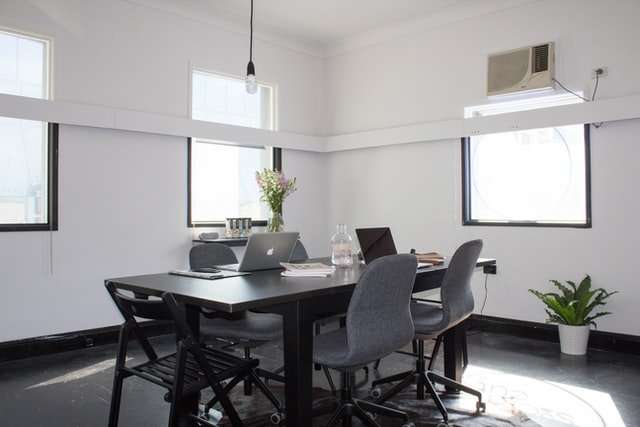The corporate art style also referred to as “corporate art design”, is the design of a company’s visual identity. This process usually involves creating a visual theme or image campaign including a distinctive logo and identifying color schemes, images, fonts, etc.
Table of Contents
Corporate artwork should be classy, elegant, and understated
Corporate artwork should convey a sense of luxury, elegance, and understated refinement. Simplicity should be the rule, and complexity the Exception. Corporate art should reflect the corporate culture and augment it by existing in the same space.
Corporate art should be real art, created by professional artists. It should not be clip art. Although clip art used to be cheap, with the Internet it has become more expensive. The costs of sending an image to an artist are comparable to the costs of producing it. And the Internet has made art more available than ever before, so there are fewer and fewer compelling reasons to use clip art.
Corporate art should not be simply an image. It should be well designed and reflect the principles of good design, such as balance, contrast, and proportion. Good design is a matter of taste, not rules; the principles are guidelines, not commandments.
Corporate art should be physical, not virtual. It should be printed on paper, not pixels. You should touch it, look at it, hold it in your hands. When art isn’t physical, it doesn’t become part of you.
Corporate art should be original, not derivative. The history of art is full of derivative examples, but that does not make it a good thing. Good art is a synthesis of ideas, and it should be read as such.
Corporate art should be corporate. It should be relevant to the company, and reflect its culture, its values, the people who work there, and its customers. Above all, it should be classy. It should enhance the corporate culture, not destroy it.
A large canvas with an artistic feel is the most common style
Corporate art has a distinctive style. It has a corporate feel, and reflects a belief that art is a service function, like accounting or human resources. It is sometimes called “functional art,” but that term can be misleading.
Functional art is not made for its own sake. It is not meant to make your heart sing. Functional art is functional, so it has to fulfill some purpose.
In contrast, corporate art has a corporate feel. It is made to be recognizable as corporate art, and in that sense it has to please the people paying for the art. It has to express the company’s brand, or its corporate culture. It has to look professional, to convey a sense of competence, and to command respect. It has to appear impressive.
The corporate artist faces three problems.
- Corporate art has to look impressive.
- It has to express the company’s brand.
- It has to look professional, convey a sense of competence, and command respect.
Corporate artists must strike a balance between these three conflicting goals. They have to do all these things, and if they don’t, they won’t sell.
The corporate artist is usually hired as part of a larger project. She’ll be asked, for example, to design a company logo that will be used on letterhead, brochures, and business cards. She’ll be asked, for example, to design a brochure or a website. She’ll be asked, for example, to design advertisements. She’ll be asked, for example, to design a trade show booth. She’ll be asked, for example, to design a conference room. She’ll be asked to design something more ephemeral, such as stationery.
Make sure your art isn’t too distracting or intrusive
Corporate art has two main problems.
The first problem is that it is distracting and intrusive. When people are surrounded by it all day every day, it tends to get annoying. It distracts people from their work, making them less productive. It distracts them from thinking about other things, like their friends, their families, or politics. It distracts them from the things their real job requires them to do.
The second problem is that corporate art is, well, bad art. It is forgettable, unimaginative, and superficial.
People tend to remember negative things, and they tend to remember bad art. When people see something bad, they tend to remember it and don’t want to see it repeated. And they try hard not to see it, thinking if they see it too often they’ll start thinking it’s normal. They’ll begin to associate bad art with their jobs, with work in general.
If we manage to avoid this, then corporate art can affect their employees. Bad art destroys people’s motivation; if they can’t picture themselves being happy doing their work, they won’t do it. If the only people they see doing their work are people in bad art, they’ll start to wonder why they are doing it their way and not their way, and that will make them unhappy.
So corporate art has two main problems. Distracting people are bad for business. Making people unhappy is bad for business.
Choose a bold color palette for your company.
The same colors used over and over create monotony. Using a set palette of colors helps to create a certain mood among your readers.
Big companies often have distinct brand identities that they use consistently across all their marketing. But smaller businesses often don’t.
Whatever your company’s size, your color scheme should be consistent. A consistent color scheme helps readers create a mental image of your brand. It also makes it easier for them to identify you and your company.
The colors you use are essential if you’re using your website to promote your company. Especially if you’re selling a product, it’s crucial to associate a color with a product. A green logo for an energy drink, for example, would be hard to make memorable, whereas a white background, black lettering, and red logo for the energy drink Red Bull make it clear that this is the drink.
For a website that’s promoting your company’s services, use colors that convey your message. If your primary audience is women, blue fonts and pastel colors probably make more sense than red fonts and neon colors.
The colors you use don’t have to be neutral. Your colors should help readers create an image—and experience—of your brand.
Simple elements, simple shapes, and fonts (linear and sans serif)
Corporate art is usually about simplicity. This is not something abstract artists understand. They want to make significant, dramatic, complicated pictures. But corporate art has to communicate simple ideas, and simple ideas are usually about business. So corporate art has to make itself look simple, too.
The best corporate art uses simple shapes (workplace objects) and simple fonts (black letters on a white background, usually sans serif). A picture that is too complicated, or uses too many shapes or fonts, is harder to read.
The most successful corporate art also avoids color. You hardly ever see color in corporate art, and when you do, it’s usually blue, which is the least threatening color.
Corporate art is not serious art. The purpose of corporations is to make a profit, and art is not often the best way to do that. But corporate art does communicate. It tells people what a business is, or what it does, and what it stands for. So corporate art is essential.
One company that makes good corporate art is Nike. Nike’s logo, the swoosh, is simple, geometric, and recognizable. It stands for speed, power, and athleticism.
Another logo that communicates is elegant and straightforward: Apple’s. The apple is not a piece of fruit but a computer. The computer industry is not an art industry, but Apple, like Nike, has made itself look good.
Compliment the brand’s feeling you want to evoke
We all have “brand feelings,” if you like. We want our brands to make us feel a certain way: we want to feel cool, or competent, or confident, or powerful, or whatever it is. But to get the feeling we want, we have to create the feeling we want.
That is the job of the art director. Art directors are people who care a lot about feeling. They define their brands, and then they design the look and feel of the brand. The look and feel are the logo, the typography, the colors, and the style. The look is the tone of voice: what you want people to hear when they read the label, watch TV ads, or read newsletters. The style is how the brand looks and feels. The style is the feel.
The look and feel are the visual side of the brand. The feel is the emotional side.
Most brands want to be cool, like Coca-Cola or Nike. But cool brands are deliberately uncool. Like Budweiser, or Dell. They are deliberately boring, because boring is reassuring, and reassuring is trustworthy. The feeling you are trying to get is confidence. A cool brand is deliberately uncool because uncool is the opposite of confident. A cool feeling feels risky. A cool feeling feels new. A cool feeling feels dangerous.
Creative directors have to learn both the look and the feel of their brands. It’s a tough job, because brands are so complex. The look and feel are all interrelated, and it’s hard to get them all right. It’s hard to get the logo right, the typography, the color, the font, and the pictures. And it’s even harder to get the feel right.
Sculptures, flowers, posters and paintings
A great corporate image can convey a huge amount of meaning, especially to people who don’t know a lot about the company.
The corporate image tells a story, and the story tells people what the company is about. The lion and olive branch on the McDonald’s sign, for example, evokes a notion of familiarity and friendliness. The image of IBM’s towering red-brick headquarters in the New York skyline, and the cherry tree on a building near Grand Central, suggest stability and strength.
The corporate image helps set expectations. When you buy a calculator from Hewlett-Packard, you can expect it to look a certain way. When Apple introduces a new version of the Macintosh computer, people expect it to look a certain way.
A corporate image also gives people a shorthand way of judging the company’s competence. An Apple computer with a Macintosh logo on it indicates a certain standard, a level of quality. A company can’t achieve that standard all at once. It must achieve it one piece at a time. Each new computer shows that the company has been making progress.
A corporate image helps people make a quick assessment of the company’s culture. The lion and olive branch on the McDonald’s sign refers to the idea that customers come first. The image of the cherry tree at the New York headquarters stands for the idea that Apple is a place where people have fun, a place where people are encouraged to be creative.
The corporate image also makes it easier for new employees to learn about the culture. The lion and olive branch, for example, is shorthand for the phrase “people come first.” The apple on the building stands for the “think different” slogan.



